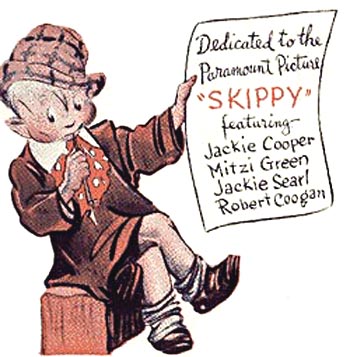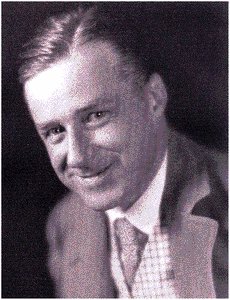George M. Moffett
By Richard Sanders, Editor, Press for Conversion!
Moffett is known to have donated at least $10,000 to
American
Liberty League and $7,500 to one of its front groups, the
Crusaders.
As president of the Corn Products Refining Co. (CPRC), Moffett
presided over some of the country’s most advanced, chemistry
labs. CPRC processes made pure starch, for corn “syrup,”
and had invented Mazola oil in 1910. Corn is more than just a
food, it’s also a source of raw power, metaphorically and
literally. In 1906, the leading U.S. corn refiners merged into
one huge company, with capital of $33 million. It was organized
by Edward Bedford, of Thompson & Bedford Co., a marketing
firm for Rockefeller’s
Standard Oil lubricants. Bedford, a Standard Oil director since
1903, also had a brother and cousin on the board. By 1912, CPRC
was one of the world’s largest company. In 1916, Judge Learned
Hand ruled against the edible oil, “Glucose Trust.”
During that suit, a memo was exposed in which the CPRC president
said, “We have built a Chinese Wall around our competitors
and have them in chains.” (For decades, CPRC fought antitrust
actions and continued its predatory practices.) By 1919, CPRC
controlled Canada Starch and the plot thickened. In the 1920s
and 1930s, CPRC’s alcohol distilleries were linked to the
mafia’s National Crime Syndicate, that was bootlegging liquor.
In those years, CPRC was among fewer than two dozen companies
that dominated U.S. investments in Germany. When Germany’s
Knorr Co. needed infusions of cash starting in 1922, the CPRC’s
German subsidiary got loans from the U.S. head office. By 1958,
CPRC owned Knorr completely.
In a joint venture with Texaco called Pekin Energy, CPRC uses
corn starch to make millions of gallons of Ethanol per year. The
history of this fuel is instructive. When Germany’s oil supplies
were threatened in 1915, they switched to ethyl, thus prolonging
WWI. In the 1920s, Henry Ford, author of The International Jew:
Jewish Influences in American Life, one of Hitler’s greatest
fans and financiers and president of the Ford Motor Co., called
ethyl the “fuel of the future.” By the 1930s, there
was much research into the fuel. Ethyl-gas use was growing, especially
in Europe, but the major oil firms squashed it by acquiring control
over industrial alcohol production. Between 1913 and the 1930s,
the U.S. government’s anti-trust committees looked into this
sinister connection. Investigations into Standard Oil’s links
to I.G. Farben, in the early 1940s revealed that du Pont, a top
oil behemoth, owned large U.S. and Cuban distilling firms. As
mentioned above, a Standard Oil director/marketer was instrumental
in the formation of CPRC. Just before WWII, the U.S. dropped its
antitrust cases. However, top oil industry directors did have
to resign and oil firms’ supposedly sold off their alcohol
distillery stocks.
Vast investments in Germany, and the financing of fascist groups
in the U.S., were not obstacles to Moffett’s involvement
in government war planning. In 1940, Roosevelt appointed Moffett
to the Council of National Defense, which oversaw industrial production.
GM executive and Nazi admirer, William
Knudsen, oversaw the government’s National Defense Advisory
Commission. He had senior officials from large industries advising
on construction, machine tools, heavy ordnance, aircraft, shipbuilding,
small arms and ammunition. Advising on chemicals was George Moffett,
for the CPRC.
In 1942, the U.S. government seized American assets of I.G.
Farben, the Nazi’s top chemical/munitions cartel, namely,
General Aniline & Film (GAF), General Dyestuffs, its 50% holding
in Winthrop Chemical and its Jasco stock (in trust for Standard
Oil, NJ). The U.S. Alien Property Custodian imposed new managers
on these Nazi-linked companies, but the Justice Department’s
Antitrust Division (AD) objected to the managers chosen. One was
a U.S. oil firm official. An AD official said: “the connection
between I.G. Farben and all oil concerns here is well-known.”
Despite having major chemical subsidiaries and investments in
Germany, another new manager came from CPRC. The AD said: “It
can be assumed that [CPRC’s German] subsidiaries... are connected
by cartel agreements with other German chemical works, especially
I.G. Farben.” In the early 1930s, CPRC and GAF were linked
through Gibson Island Research Conferences, which brought together
top U.S. corporate chemists on a secluded island. Other American
Liberty League-linked chemical firms, also networked at these
intimate getaways: du
Pont, Firestone, H.J.Heinz,
Pittsburgh Plate Glass, Standard Oil and Sun
Oil.

 Perhaps
the saddest chapter in CPRC’s litany of scandals was its
role in stealing Skippy, a popular comic strip that hit the papers
in the early 1920s. It’s maverick creator, Percy Crosby,
knew General
Smedley Butler and shared his convictions. Crosby used his
cartoon character to tackle politicians, corporate criminals,
Al Capone’s mafia and the KKK. Skippy ran worldwide from
1926 to 1945 and championed civil rights, child labour laws and
free speech. Crosby became a wealthy man but was obviously a threat
to the upscale fascist, corporate elite and seamy underworld gangsters.
Then, in 1933, along came a bankrupt company, Rosefield Packing.
It stole the good Skippy name, its lettering and distinctive graphics
and used them to sell peanut butter. They even had a “Skippy”
radio show, 1933-1935. It was sponsored by an I.G. Farben subsidiary,
Sterling Products Co., and a CPRC official was on the Sterling
Drug Co. board.
Perhaps
the saddest chapter in CPRC’s litany of scandals was its
role in stealing Skippy, a popular comic strip that hit the papers
in the early 1920s. It’s maverick creator, Percy Crosby,
knew General
Smedley Butler and shared his convictions. Crosby used his
cartoon character to tackle politicians, corporate criminals,
Al Capone’s mafia and the KKK. Skippy ran worldwide from
1926 to 1945 and championed civil rights, child labour laws and
free speech. Crosby became a wealthy man but was obviously a threat
to the upscale fascist, corporate elite and seamy underworld gangsters.
Then, in 1933, along came a bankrupt company, Rosefield Packing.
It stole the good Skippy name, its lettering and distinctive graphics
and used them to sell peanut butter. They even had a “Skippy”
radio show, 1933-1935. It was sponsored by an I.G. Farben subsidiary,
Sterling Products Co., and a CPRC official was on the Sterling
Drug Co. board.
The CPRC sugared up “Skippy” peanut butter and later
purchased Rosefield. Crosby had to fight a David-and-Goliath-style
legal battle against CPRC. It turns out that Crosby’s lawyer,
Herbert Brownell, also worked for the CPRC! Brownell later became
Attorney General for Eisehower and Nixon. Crosby’s daughter,
Joan, notes that
"’Wild Bill’ Donovan, former head of the [Office
of Strategic Services, the CIA’s forerunner], was one of
my father’s former lawyers. Allen Dulles and [brother] John
Foster [were lawyers] with the Sullivan & Cromwell law firm
(which was lead counsel for Best Foods in 1954 when it ‘bought’
Skippy assets from Rosefield Packing)."
In 1958, CPRC and Best Foods merged to form CPC. The McCarthy-era
legal battle over Skippy devastated Crosby. He was forced into
a psychiatric institution for 16 years until his death in 1964.
His efforts to contact family, friends and authorities were thwarted.
Crosby’s daughter says he
"was a political prisoner of the powerful Corn Products
Corp., which had stolen his Skippy business, destroyed his reputation
and career, and looted his estate of valuable assets. My father
was held hostage by this evil combination, and died in virtual
poverty, while CPC made millions of dollars from the Skippy criminal
enterprise."
CPC has tried to ban her website <www.skippy-scam.org>.
In 1996, CPRC paid $7 million to settle a lawsuit for corn
syrup price fixing. In 2003, it was revealed that the International
Life Sciences Institute, an international “food” industry
association, had infiltrated the World Health Organisation to
exert “undue influence” over policies on diet, pesticides,
additives, transfatty acids, sugar and genetically modified foods.
It was founded in 1978 by the Heinz Foundation. Among its top
members are CPC International and Knorr. With sales of $2.3 billion
in 2003, CPC is the world’s top dextrose producer and one
of America’s top 30 industrial stocks. It has 115 plants
in 60 countries and employs 50,000. Since Unilever bought Bestfoods
in 2000, CPRC is now part of that corporate conglomerate.
References:
Richard Tedlow, "The American CEO in the 20th Century,"
2003.
http://www.hbs.edu/research/facpubs/workingpapers/papers2/0203/03-097.pdf
Corn Products Company
http://www.scripophily.net/corprodcom.html
Education
http://www.ubfoods.co.uk/education_content_knorr.htm
Bill Kovarik, "Henry Ford, Charles Kettering and the Fuel
of the Future," Automotive History Review, Spring 1998.
http://www.radford.edu/~wkovarik/papers/fuel.html
Mark Glick, Duncan Cameron, David Mangum, "Importing the
Merger Guidelines," 1997.
http://www.econ.utah.edu/les/version_2.0/papers/importing.html
Alan Gropman, "Mobilizing U.S. Industry in World War II,"
McNair Paper, 1996.
http://www.ndu.edu/inss/McNair/mcnair50/m50c5.html
Wyatt Wells, Antitrust and the Formation of the Postwar World,
2003.
http://www.ciaonet.org/book/wew01/
Russell Mokhiber & Robert Weissman, "The Surprising
Political Economy of Skippy," July 30, 1999.
http://lists.essential.org/corp-focus/msg00033.html
Joan Crosby, "Percy L. Crosby: His Life and Times,"
July 16, 1999.
http://www.skippy-scam.org/exhibit-B-1/skippy11.html
Joan Crosby, personal communication with author, February,
2004
Wall Street Journal, 5/28/1996, p. R-45, cited in Timelines
of History.
http://timelines.ws/20thcent/1958.HTML
Backgrounder
http://www.cornproducts.com/PressKit.pdf
Bestfoods
http://www1.excite.com/home/careers/company_profile/0,15623,1306,00.html
"Achtung!! September Blues," World Market Chronicles,
Oct. 2002.
http://www.depression2.tv/chronicles/september-blues.html
Sarah Boseley, "WHO 'infiltrated by food industry,"
The Guardian, Jan. 9, 2003.
http://www.guardian.co.uk/uk_news/story/0,3604,871228,00.html
Source: Press for Conversion!
magazine, Issue # 53, "Facing the Corporate Roots of American
Fascism," March 2004. Published by the Coalition to Oppose the Arms Trade.
Order a Copy: Order
a hard copy of this 54-page issue of Press for Conversion!
on the fascist plot to overthrow President F.D.Roosevelt and
the corporate leaders who planned and financed this failed coup.

 Perhaps
the saddest chapter in CPRC’s litany of scandals was its
role in stealing Skippy, a popular comic strip that hit the papers
in the early 1920s. It’s maverick creator, Percy Crosby,
knew General
Smedley Butler and shared his convictions. Crosby used his
cartoon character to tackle politicians, corporate criminals,
Al Capone’s mafia and the KKK. Skippy ran worldwide from
1926 to 1945 and championed civil rights, child labour laws and
free speech. Crosby became a wealthy man but was obviously a threat
to the upscale fascist, corporate elite and seamy underworld gangsters.
Then, in 1933, along came a bankrupt company, Rosefield Packing.
It stole the good Skippy name, its lettering and distinctive graphics
and used them to sell peanut butter. They even had a “Skippy”
radio show, 1933-1935. It was sponsored by an I.G. Farben subsidiary,
Sterling Products Co., and a CPRC official was on the Sterling
Drug Co. board.
Perhaps
the saddest chapter in CPRC’s litany of scandals was its
role in stealing Skippy, a popular comic strip that hit the papers
in the early 1920s. It’s maverick creator, Percy Crosby,
knew General
Smedley Butler and shared his convictions. Crosby used his
cartoon character to tackle politicians, corporate criminals,
Al Capone’s mafia and the KKK. Skippy ran worldwide from
1926 to 1945 and championed civil rights, child labour laws and
free speech. Crosby became a wealthy man but was obviously a threat
to the upscale fascist, corporate elite and seamy underworld gangsters.
Then, in 1933, along came a bankrupt company, Rosefield Packing.
It stole the good Skippy name, its lettering and distinctive graphics
and used them to sell peanut butter. They even had a “Skippy”
radio show, 1933-1935. It was sponsored by an I.G. Farben subsidiary,
Sterling Products Co., and a CPRC official was on the Sterling
Drug Co. board.